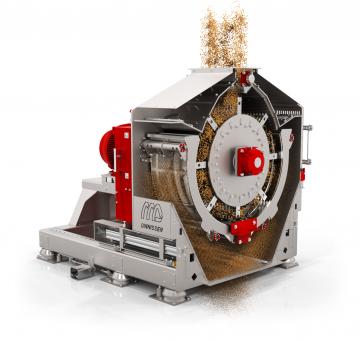The hammer mill is a machine that is used for grinding materials in various industries. This article takes a closer look at various aspects of the hammer mill such as:
- The advantages and disadvantages of a hammer mill in a row
- The working mechanism of the hammer mill
- How is the efficiency of hammers affected
- How does the sieve affect the hammer mill
- How can the grinding process run smoothly
- Counteracting unwanted objects, noise nuisance, and explosion risk
The experts at Dinnissen Process Technology are available to answer all your questions:
Get in touch with Juul Jenneskens 077 467 3555
The advantages and disadvantages of a hammer mill in a row
A hammer mill is a crusher that is used in various industries, such as the food and feed industry, but also in completely other industries such as recycling. The main reasons that the hammer mill is often used are the highly efficient grinding process, high reliability and low noise level. The hammer mill is used for grinding soft to medium hard materials. The fineness of the grinding process is in the range of 0.1 - 10 mm. A hammer mill has certain advantages and disadvantages.
The advantages of the hammer mill are:
- Suitability for grinding softer materials with a fibrous structure.
- The relatively simple construction. This makes it easy to keep the machine clean and maintain it.
- The high reduction rate. It is possible to achieve a reduction of 50x or more. This means that particles of 50 mm can be reduced in one process step to particles of 1 mm.
The disadvantages of the hammer mill are:
- Less suitable for hard materials.
- Relatively high energy consumption. The energy consumption of the hammer mill is higher than that of the roller chair or the multicracker. This depends on the product to be ground, but in many situations the hammer mill consumes almost twice as much energy than the other two mentioned devices.
- The hammer mill generates a relatively large amount of unwanted fine material. This makes the hammer mill less suitable for the production of powders that may contain little dust.
- Risk of damage from metal objects or large stones.

Lorem ipsum
The working mechanism of the hammer mill
The hammer mill works based on a fast spinning rotor to which several hammers are attached. This rotating mechanism is placed in a grinding room where the raw materials to be ground are introduced. The hammers then beat the input material to pieces at high speed. As soon as the grind is fine enough, the product can leave the grinding space through the air and the sieve at the bottom of the grinding space. The fineness of the grind depends on several factors:
- the hammers,
- the sieve,
- the properties of the raw materials to be ground,
- speed hammers,
- air flow / speed.
How is the efficiency of hammers affected
The effectiveness of the hammers is determined by several aspects:
- The number of hammers,
- The geometry of the hammers,
- The distance between the hammers,
- The distance from the hammers to the sieve plate,
- The speed of the rotor and thus the speed of the hammers.
The impact that the hammers give to the raw materials to be ground is the first step in the direction of the desired product. To get a good grinding, it is necessary to set the speed of the rotor to the correct value. The outside of the hammer furthest from the rotor has a speed between 80 and 120 m / s. To achieve the maximum impulse, the hammers must be very hard on the outside. Close to the rotor, the hammer should be more elastic to prevent the hammer from breaking if an unwanted hard object enters the grinding chamber.
The product properties also influence the grinding process. Brittle and crystalline raw materials require a lower impact than materials with a fibrous and tough structure. For that reason, industrial hammer mills are equipped with a frequency regulator to determine the speed of the rotor.
The hammer shape also influences the achievement of the desired product. For some products it is better to mount hammers in the shape of a beam, other products need hammers in the form of plates or T-shapes.

Lorem ipsum
A constant supply flow of product affects the efficiency of the grinding process
How does the sieve affect the hammer mill
In industrial hammer mills there is a sieve system in which several sieves are housed. The sieve influences the performance of the hammer mill in several ways.
The distance from the sieve to the hammers is 2 - 4 mm. This distance determines the fineness of the grind produced.
The diameter of the perforations in the sieve influences the quality of the grind. The diameter of the perforation determines the maximum size of the grains that can pass through the screen. The effectiveness of the screening is partly determined by the number of holes in the screen in relation to the size of the holes. If the distance between the perforations is too great, there is a risk that the material will stick or stick between the holes and that clumping will occur.
The sieve system is responsible for a large part of the total energy consumption of the hammer mill. This can vary from 15 - 40%, depending on the material to be processed. The finer the sieve, the higher the energy consumption. It takes more energy to grind with a sieve with small perforations than with a sieve with larger openings. The shape of the perforations also affects energy consumption. Round perforations lead to less friction than lamella-shaped holes and thus ensure lower energy consumption.
A screen damaged by wear can increase the power consumption of the hammer mill by 25%. In addition, a worn sieve can influence the product properties of the grind. These two reasons are an important reason to replace the sieve regularly. The procedure and frequency for replacing the screen can be included in the maintenance plan. Preferably, changing the screen is a quick and easy process. For this reason, industrial hammer mills are often equipped with a semi- or fully automatic system for changing the screens.
How can the grinding process run more efficiently
A constant supply flow of product affects the efficiency of the grinding process. If there is an accumulation of material in the grinding chamber or if the grinding chamber is not evenly loaded, the grinding process will not proceed in an optimal manner and the energy consumption will increase. By blowing air into the supply of the ground material, a more homogeneous and open structure is created. This makes the grinding process more efficient and the capacity can be increased by up to 40%. The supply of air also has a cooling effect and ensures that the material does not heat up too much. This is beneficial for products that become sticky as a result of the higher temperature and are therefore harder to grind. If a mixture of ground materials has to be produced, there are two possibilities. One option is to first grind the two materials separately and then mix them. The other option is to mix the unground materials first and then grind the mixture as a whole. Research shows that the second grinding method is the most effective.
Counteracting unwanted objects, noise nuisance and explosion risk
Installing a magnet reduces the risk of damage to the screen and removes unwanted metal objects.
The grinding of materials in a hammer mill results in a certain noise level. This is partly inherent to the process. One of the causes is high engine speed. It can be driven at 3000 rpm. It is possible to make a hammer mill with 1500 revolutions / min. This generates less noise than at 3000 rpm. To achieve the same impact on the product with this lower speed, hammers are equipped with a rotor diameter twice as large. The larger rotor results in a larger grinding chamber. The capacity of the hammer mill will increase. Due to the larger grinding surface and sieve surface, grinding will be 20-25% more efficient.
Sometimes ground products are highly flammable or explosive. This is especially true for finely ground products and when dust is released. If there is a real explosion risk, it is possible to provide the hammer mill with explosion protection. Safety valves are then installed. These valves open or close automatically if the pressure in the grinding chamber becomes too high.

Name: Juul Jenneskens
Advisor
Please feel free to contact me if you have any questions about this subject. My team of colleagues and I are ready to answer!
Get in touch with Juul Jenneskens 077 467 3555 [email protected]
Do you prefer to request a consultation directly?
